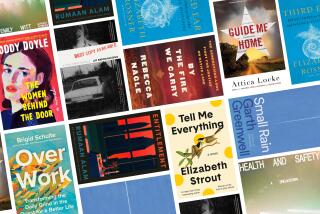NO LEASE ON LIFE.<i> By Lynne Tillman</i> .<i> Harcourt Brace: 192 pp., $23</i>
Peering from her fifth-floor window at the 5 a.m. hubbub in the slummy street below, Elizabeth is a nerve drawn out to a guitar stringâs snapping point. Not yet quite snapped, what a note it emits!--high, ravishing and dangerous.
In all likelihood it never will snap, despite the periodic buzz and shriek of coil and nylon fraying. Elizabeth, in Lynne Tillmanâs fictional insomniacâs diary, is the indomitable New Yorker, a figure as plucky, bashed-about and memorable as Londonâs all-but-vanished Cockney.
âCitizen of no mean cityâ was the ancient Romanâs boast. âBorn within the sound of Bow bellsâ was the Cockneyâs. The New Yorkerâs is: âI am shoved, hassled, threatened, scared, kept up at night by screams and hurled garbage cans, and when I walk out with my dog for protection, I bear in these poetâs, artistâs, copywriterâs, bank clerkâs, proofreaderâs hands (thanks to the Pooper Scooper law) its Baggied excrement. And I am here.â
Scouring her wit of the jaunty ruefulness so often used in writing of New York hardship, Tillman chisels and shapes. The epigraphs for her comic and moving book come from Hebrews and William Carlos Williams. She might well have used a celebrated graffito of 50 years ago, when a high-minded bureaucrat plastered the city with âDid You Make New York Dirty Today?â signs. The rejoinder scrawled on one of them: âNew York Made Me Dirty Today.â
This, in sum, is the plaint of Elizabeth, who is in her 30s, has held the same lowly job for seven years in the proofroom of a prestigious magazine and lives with Roy in a tenement apartment on the Lower East Side. He is a little more successful, better at coping with the city or shutting his eyes to it, and considerably nicer. It is because Elizabeth will not cope, cannot shut her eyes and refuses niceness that she becomes our latest urban heroine.
Her heroism is of the Don Quixote variety, except that in Elizabeth, the bruises are more spectacular than the windmills that caused them. Her unremitting and wonderfully varied protest is doomed to failure, though; like Don Quixoteâs, her defeats elevate the world by an inch or two.
You survive the city by shutting your eyes to most of it. Elizabeth, optic nerve jangling, is an unremitting noticer. The 24 hours covered by âNo Lease On Lifeâ begin in predawn darkness on what will be a hot June day. Wild shrieking and crashing yank Elizabeth out of bed where Roy sleeps obliviously and take her to the window. A drunken crowd of young men and women is throwing garbage cans at the parked cars, scattering the contents and smashing windows.
It is the âmoronsâ (Elizabeth: âAny moron can hit a car with a garbage canâ) on another of their periodic rampages. Unable, as so often, to sleep, Elizabeth sits down by the window to record a journal of cyclical outrage. Before long, the âcrustiesâ will awake: drugged-out young people who live on the street and harass and threaten the passersby--and later the hookers and drug dealers.
Elizabethâs window is both vantage point and mirror. She looks out at the street and inward at her life, her tenement building, her job and Roy. It is a chronicle of New York for the new dispossessed: the low-income middle class whose only wisp of security is a toehold on a rent-stabilized apartment on a rotting block.
Elizabethâs jottings, excursions, speculations have a brilliantly manic and depressive quality reminiscent of Renata Adlerâs âSpeedboatâ of two decades ago. The New York life she depicts, though, locates its anxieties and horrors much lower on the economic and social scale. The images of violation and bloodshed are in no way metaphoric; there is only a frail barrier or two between Elizabeth and the destitute on the street and in the welfare apartments in her own building. Everything invades or threatens to: the din and violence, the filth and neglect of the apartment house, the threat of crime.
What distinguishes Elizabeth, though, is that she insists not only on watching and commenting but on sallying out and engaging. At 6 a.m.--for New Yorkers, who go to bed late, the early morning hours are the middle of the night--an engine revs up. It is Ahmed, the super across the street, incessantly working on his car. Elizabeth puts on a robe and heads for the door. Roy, half awake, tells her not to go out; she could be killed.
âShe might have to die to sleep,â Elizabeth thinks. Roy pulls the blanket over his head and turns his back. âRoy returned to Royâs world,â she reflects. âHeâd already accepted Elizabethâs death.â
Elizabethâs world demands action, however unpromising. She strides across the street to lecture Ahmed about illegal noise and peopleâs right to sleep. Wordless (he barely speaks English), he stares at her--murderously, she is sure--before resuming work.
Returning to her apartment--it is a typical New York standoff: all fury and no action--she feels equally murderous. Much of the time, in fact, she imagines killing her urban tormentors, possibly with a crossbow. Her fantasies retaining a shred of political correctness, her imagined victims are invariably white; also, she wonders whether reading is available in jail.
During the day, she does errands. In New York, errands are not sanitized; each one is an intense personal encounter. She complains to the local postmaster about the length of a clerkâs fingernails; he regards her blankly. The Korean florist runs out to tell her he loves her. At the Syrian grocer, a teenager offers to âjump her bonesâ; he is too young, she replies.
She is no prude; she is mildly aroused at seeing a hooker fellating a customer on a doorstep. Itâs not the sight itself but imagining a handsome neighbor watching it from his own window upstairs. As for Roy, she enjoys sex with him even though itâs fairly boring. When she asks why he is not as seductive as a man in a TV ad who caresses his partner with a silk scarf, Roy replies reasonably: âWeâve never been in a commercial together.â
Elizabethâs encounters are mostly defeats. It is not her fellow New Yorkers she is arguing with; it is New York, which never replies and goes on doing what it is doing. Her intrepidity amid her own timidity makes her appealing; so does her persistence in talking to people. Two of the bookâs finest and most moving passages come when she listens to the stories of Jeanie, a hooker, and Paulie, a street derelict. Both accounts are drawn from real-life characters; both are told with heartbreaking lucidity.
Tillman has done a different kind of research as well. She has gathered a series of New York jokes from friends and acquaintances and interspersed them among Elizabethâs sallies and broodings. Some are good, some vile; cumulatively they augment the sense of disconnection in the world with which her protagonist--endearingly, bravely, vainly--tries to connect.
More to Read
Sign up for our Book Club newsletter
Get the latest news, events and more from the Los Angeles Times Book Club, and help us get L.A. reading and talking.
You may occasionally receive promotional content from the Los Angeles Times.








